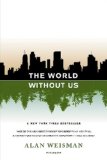Summary | Excerpt | Reviews | Beyond the Book | Readalikes | Genres & Themes | Author Bio

Critics' Opinion:
Readers' Opinion:
First Published:
Jul 2007, 336 pages
Paperback:
Aug 2008, 368 pages
 Book Reviewed by:
Book Reviewed by:
BookBrowse Review Team
Buy This Book
East of the San Francisco Peaks are the even taller
Rockies; to their west are the Sierra Madres, whose volcanic summits are higher
still. Impossible as it is for us to fathom, all these colossal mountains will
one day erode to the sea—every boulder, outcrop, saddle, spire, and canyon wall.
Every massive uplift will pulverize, their minerals dissolving to keep the
oceans salted, the plume of nutrients in their soils nourishing a new marine
biological age even as the previous one disappears beneath their sediments.
Long before that, however, these deposits will have been
preceded by a substance far lighter and more easily carried seaward than rocks
or even grains of silt.
Capt. Charles Moore of Long Beach, California, learned that
the day in 1997 when, sailing out of Honolulu, he steered his aluminum-hulled
catamaran into a part of the western Pacific he'd always avoided. Sometimes
known as the horse latitudes, it is a Texas-sized span of ocean between Hawaii
and California rarely plied by sailors because of a perennial, slowly rotating
high-pressure vortex of hot equatorial air that inhales wind and never gives it
back. Beneath it, the water describes lazy, clockwise whorls toward a depression
at the center.
Its correct name is the North Pacific Subtropical Gyre,
though Moore soon learned that oceanographers had another label for it: the
Great Pacific Garbage Patch. Captain Moore had wandered into a sump where nearly
everything that blows into the water from half the Pacific Rim eventually ends
up, spiraling slowly toward a widening horror of industrial excretion. For a
week, Moore and his crew found themselves crossing a sea the size of a small
continent, covered with floating refuse. It was not unlike an Arctic vessel
pushing through chunks of brash ice, except what was bobbing around them was a
fright of cups, bottle caps, tangles of fish netting and monofilament line, bits
of polystyrene packaging, six-pack rings, spent balloons, filmy scraps of
sandwich wrap, and limp plastic bags that defied counting.
Just two years earlier, Moore had retired from his
wood-furniture-finishing business. A lifelong surfer, his hair still ungrayed,
he'd built himself a boat and settled into what he planned to be a stimulating
young retirement. Raised by a sailing father and certified as a captain by the
U.S. Coast Guard, he started a volunteer marine environmental monitoring group.
After his hellish mid-Pacific encounter with the Great Pacific Garbage Patch,
his group ballooned into what is now the Algita Marine Research Foundation,
devoted to confronting the flotsam of a half century, since 90 percent of the
junk he was seeing was plastic.
What stunned Charles Moore most was learning where it came
from. In 1975, the U.S. National Academy of Sciences had estimated that all
oceangoing vessels together dumped 8 million pounds of plastic annually. More
recent research showed the world's merchant fleet alone shamelessly tossing
around 639,000 plastic containers every day. But littering by all the commercial
ships and navies, Moore discovered, amounted to mere polymer crumbs in the ocean
compared to what was pouring from the shore.
The real reason that the world's landfills weren't
overflowing with plastic, he found, was because most of it ends up in an
ocean-fill. After a few years of sampling the North Pacific gyre, Moore
concluded that 80 percent of mid-ocean flotsam had originally been discarded on
land. It had blown off garbage trucks or out of landfills, spilled from railroad
shipping containers and washed down storm drains, sailed down rivers or wafted
on the wind, and found its way to this widening gyre.
"This," Captain Moore tells his passengers, "is where all
the things end up that flow down rivers to the sea." It is the same phrase
geologists have uttered to students since the beginning of science, describing
the inexorable processes of erosion that reduce mountains to dissolved salts and
specks small enough to wash to the ocean, where they settle into layers of the
distant future's rocks. However, what Moore refers to is a type of runoff and
sedimentation that the Earth had hitherto never known in 5 billion years of
geologic time—but likely will henceforth.
Copyright © 2007 by Alan Weisman. All rights reserved.





The Funeral Cryer by Wenyan Lu
Debut novelist Wenyan Lu brings us this witty yet profound story about one woman's midlife reawakening in contemporary rural China.
Your guide toexceptional books
BookBrowse seeks out and recommends the best in contemporary fiction and nonfiction—books that not only engage and entertain but also deepen our understanding of ourselves and the world around us.